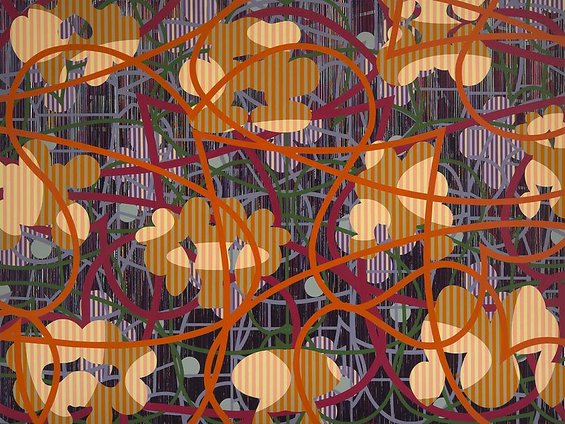
Charles Burwell, 1955
Artist Statement:
Some of my earliest artist influences were Cy Twombly, Mark Tobey, Agnes Martin and Jack Tworkov. Since the mid 1970’s, around the time I saw a Cy Twombly exhibition at the ICA in Philadelphia, the use of the linear mark has been a constant element in my work. That linear, graphic sensibility that I saw in these artists had a great influence on the development of my art, and it has continued to evolve in my work over the years. The exploration of complex linear elements continues to be a dominant part of how I develop paintings and drawings. Another aspect of my work that had its spark in the 1970’s when I was in art school is an interest in process. Through visits to the Museum of Modern Art and seeing the range of American abstract art (particularly Pollock), I became interested in the formal ways in which paintings are constructed.
Purple Vista, 2014.
The work I’ve been doing since the early 1990’s involves a specific layering process. They mostly rely on the interaction of the controlled dripped line, maze like linear forms, and organic and geometric forms. The paintings are constructed one layer of forms at a time, starting with layers of drips that have a specific color structure. The forms I use are part of a constantly evolving vocabulary of shapes that began with organic forms I started developing in the early to mid 1980’s. At that time I was interested in pre-history, and used forms derived from biology, archeology and natural history. When developing images I still sometimes refer to the biological diagrams and photos I’ve collected over the years. Now however, they have become simplified, are less illustrative and are more general or ambiguous. The forms have their own developmental process involving genealogy and hybridization. A shape may have a familiar quality, but it remains uncertain whether its origins are organic, or derived from an industrial product. The development and evolution of the paintings are integrally connected to the evolving nature of the forms. I’ve developed hundreds of templates of varying sizes, for solid shapes as well as for liner forms. Symmetry, asymmetry, anthropomorphic, geometric, biomorphic are some of the categories of forms I use.
First One, Then Another, 2012.
The paintings and drawings have been moving toward more spatial complexity. These works have indirectly referred to connections between biology, technology, and in a way the complexities of our information-laden culture. The transparency of the layering process remains visible because of the graphic nature of the paintings. This process extends to the viewer in terms of engaging in the act of penetrating the layers, or penetrating forms within layers and navigating through the veils of imagery. How these images interrelate, their method of construction, the physical perception of these images, and how this relates to our understanding of technological space are areas I’m exploring.
New Reveal, 2012.
I’ve recently begun working with the computer. I’m using it to develop images in almost the same way that I make paintings. The process of developing and layering templates is almost identical. The difference being that one is a virtual process. Some of the recent works are with mixed media utilizing the digital process. Complexity, layering, patterning and introducing a wider range of imagery makes the use of computer technology an exciting addition to my working process.
Black on White, 2012.
Courtesy: Bridgette Mayer Gallery, 709 Walnut Street
Philadelphia, PA 19106
tel 215 413 8893

